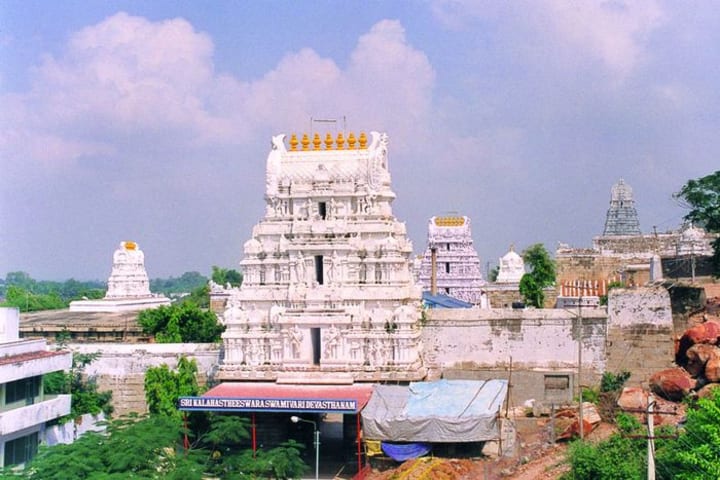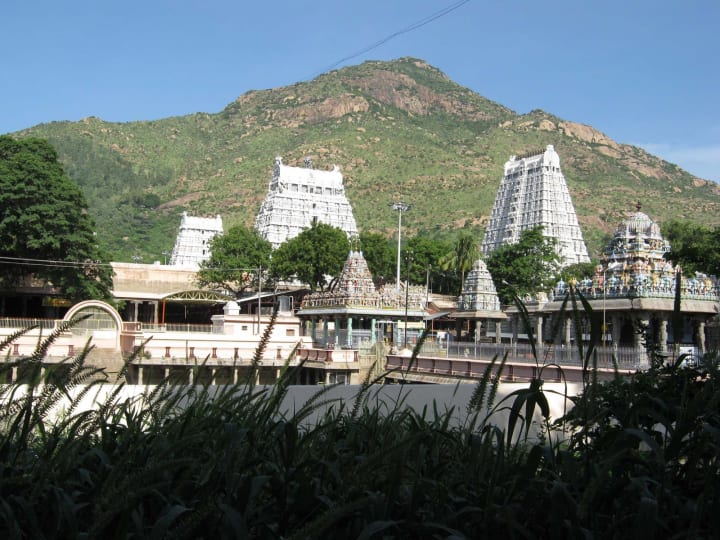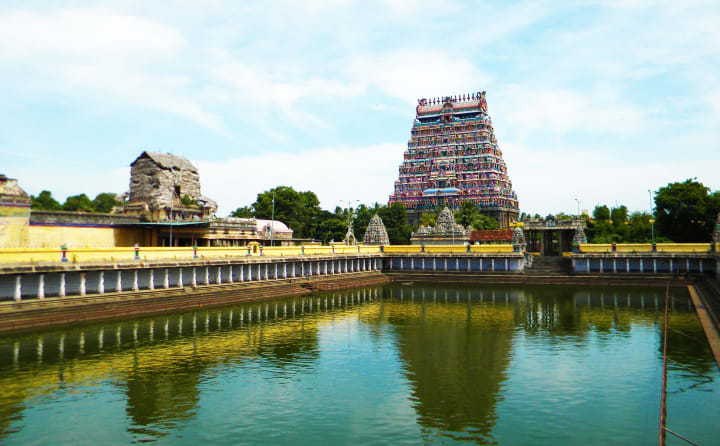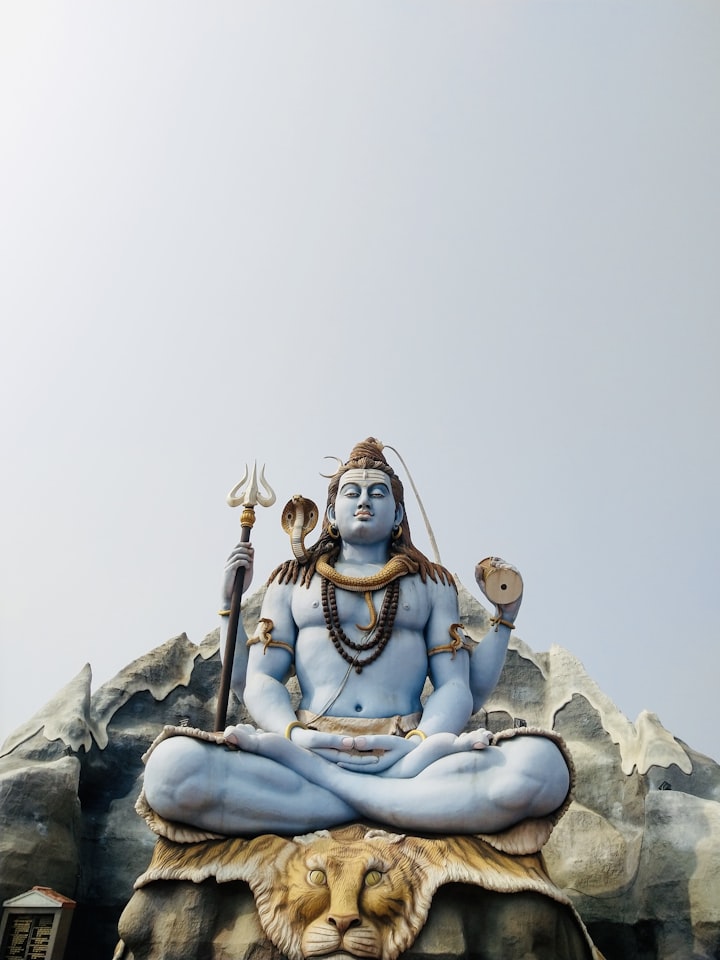
Pancha Bootha Sthalam refers to five temples dedicated to Shiva, each representing a manifestation of the five prime elements of nature: earth, water, fire, air, and ether. Pancha indicates "five," Bootha means "elements," and Sthala means "place." The temples are located in South India—four in Tamil Nadu and one in Andhra Pradesh. The five elements are believed to be enshrined in the five lingams of the temples, with each lingam named after the element it represents. All five temples are located around the 78° and 79°E longitudes and between 10° and 14°N latitudes.
The presiding deities are revered in the 7th-century Tamil Saiva canonical work, the Tevaram, written by Tamil saint poets known as the nayanars and classified as Paadal Petra Sthalam. The four temples in Tamil Nadu are maintained and administered by the Hindu Religious and Charitable Endowments Department of the Government of Tamil Nadu.
Na | Ma | Shi | Va | Ya – these five syllables indicate the five elements (known as Bhoota in Sanskrit) – Earth, Water, Fire, Air, and Ether. The five elements are the building blocks of everything in Creation, including the human body, and Lord Shiva is the upholder of the five elements.
Pancha Bootham
Pancha Bootham's five great elements, also five physical elements, are a group of five basic elements, which, according to Hinduism, are the basis of all cosmic creation. These elements are Prithvi/Bhudevi (Earth), Apas/Varuna/Jala (Water), Agni (Fire), Vayu (Air), and Akasha/Dyaus (Space/Atmosphere/Ether). These elements have different characteristics, and these also account for different faculties of human experience. In Ayurveda and Indian philosophy, the human body is considered to be made of these five elements. However, Charvakadid does not accept Akasha as a basic element, as it is not tangible, and according to them, there are only four basic elements. Hinduism influenced Buddhism, which accepts only four Mahabhutas, viewing Akasha as a derived (Upada) element. These five elements of the Indian cosmological system are similar but not identical to the five-element theory used in East Asia.
Pancha Bootha Stalams
The Air [Sri Kalahasti temple]:

Sri Kalahasti Temple is located in the town of Srikalahasti, in the Tirupati district in the state of Andhra Pradesh, India. It is one of the most famous Shiva temples in South India and is said to be the site where Kannappa was ready to offer both his eyes to cover blood flowing from the linga before Shiva stopped him and granted him moksha.
The name of Srikalahasti Temple is derived from a famous mythological legend. The myth states that a spider (Sri), a snake (Kala), and an elephant (Hasti) used to worship Lord Shiva in the town to attain Moksha. Therefore, during the Pallava period in the 5th century, the Srikalahasti Temple was built by Krishnadevraya, the king of the Vijayanagara Empire.
Srikalahasti temple, its Vayu Lingam (Wind Lingam), one of the Pancha bootha Sthalam is dedicated to air, representing wind. The temple is also regarded as Rahu-Kethu kshetra and Dakshina Kailasam. The inner temple was constructed around the 5th century and the outer temple was constructed in the 11th century by the Rajendra Chola I, later the Chola kings, and the Vijayanagara kings. Shiva in his aspect as Vayu is worshiped as Kalahasteeswara.
Timings for Visiting Sri Kalahasti Temple
The temple is open from 6:00 AM to 12:00 PM in the morning. In the evening, it opens at 5:00 PM and shuts at 9:00 PM.
The Water [Jambukeshwarar Temple]:

Jambukeswarar Temple, is a famous Shiva temple also Thiruvanaikal, Jambukeswaram in the Tiruchirapalli (Trichy) district, in the state of Tamil Nadu, India. Though it is that Kocengannan (Kochengat Cholan), one of the Early Cholas, built this temple. It is located on Srirangam island, which has the famous Ranganathaswamy temple.
One of the Pancha Bootha Sthalam is dedicated to “neer” (water) and so it is called “Appu sthalam” and the Shiva Lingam here is called ‘Appu Linga’. Inside the sanctum of Lord Jambukeswarar, there is an eternal water stream underground and people can see water coming out of the ground, and the Goddess here is “Akilandeshwari”, the ruler of the universe.
It is one of the 275 Paadal Petra Sthalams, where all the four most revered Nayanars (Saivite Saints) have sung glories of the deity in this temple. The temple has inscriptions from the Chola period.
Timings for Visiting Jambukeshwarar Temple
The temple is open from 5:30 AM to 12:00 PM in the morning. In the evening, it opens at 5:00 PM and shuts at 9:00 PM.
The Fire [Arulmigu Arunachaleswarar Temple]:

Arunachaleswarar Temple also known as Arunachalam Temple is one of the most famous temples dedicated to Lord Shiva, located at the base of Arunachala hill in the town of Thiruvannamalai in Tamil Nadu, India. It is significant to the Hindu sect of Shaivism as one of the temples associated with the five elements, the Pancha Bootha Stalas, and specifically the element of fire, or Agni.
Shiva is worshiped as Arunachaleswarar or Annamalaiyar and is represented by the lingam, with his idol referred to as Agni lingam. His consort Parvati is depicted as Unnamalai Amman or Apithakucha Ambal. The presiding deity is revered in the 7th-century Tamil Saiva canonical work, the Tevaram, written by Tamil saint poets known as the nayanars and classified as Paadal Petra Sthalam. The 9th-century Saiva saint poet Manikkavasagar composed the Tiruvempaavai here.
The temple complex covers 10 hectares and is one of the largest in India. It houses four gateway towers known as gopurams. The tallest is the eastern tower, with 11 stories and a height of 66 meters (217 ft), making it one of the tallest temple towers in India built by Sevappa Nayakkar (Nayakar dynasty) The temple has numerous shrines, with those of Arunachalesvara and Unnamalai Amman being the most prominent. The temple complex houses many halls; the most notable is the thousand-pillared hall built during the Vijayanagar period.
The present masonry structure was built during the Chola dynasty in the 9th century, while later expansions are attributed to Vijayanagara rulers of the Sangama Dynasty (1336–1485 CE), the Saluva Dynasty, and the Tuluva Dynasty (1491–1570 CE). The temple is maintained and administered by the Hindu Religious and Charitable Endowments Department of the Government of Tamil Nadu.
Timings for Arulmigu Arunachaleswarar Temple
The temple is open from 5:30 AM to 12:00 PM in the morning. In the evening, it opens at 03:30 PM and shuts at 9:30 PM.
The Earth [Ekambareswarar Temple]:

Ekambareshwarar Temple Kanchipuram temple is dedicated to lord shiva, located in the town of Kanchipuram in Tamil Nadu, India. This temple is one of the pancha bootha stalas and this temple represents Prithvi. The shrine of shiva is in the form of shiva lingam which is also called Prithvi lingam, goddess Gowridevi is placed on the side of the god Shiva. The temple has many houses as nilathingal thundam, Perumal temple, and divyadesam. The temple is considered one of the largest temples in India as it is occupied 25 acres. There are four gopurams in the temples and one of them is considered the largest gopuram in India, the gopuram at the south side is 58.5216 meters in height and is the largest one in India. From the time of the Vijayanagar period, there is a
Initially, Pallava kings built this temple in the 17th century. Adi Sankara remodeled and expanded this temple in the 10th century. Panchiyappa mudaliar visited this temple and invested a lot in the temple remodeling so that a pillar has a picture of him. In 1509, Krishna deva Raya of the Vijayanagara kingdom build a 60-meter tall gopuram, a thousand-pillared hall, and is one of the tallest gopurams in the country.
The presiding deity is revered in the 7th century Tamil Saiva canonical work, the Tevaram, written by Tamil saint poets known as the nayanars and classified as Paadal Petra Sthalam. The temple also houses Nilathingal Thundam Perumal temple, a Divyadesam, the 108 temples revered in the Vaishnava canon Nalayira Divya Prabhandam.
Timings for Ekambareswarar Temple:
The temple is open from 6:00 AM to 12:30 PM in the morning. In the evening, it opens at 04:00 PM and shuts at 8:30 PM.
The Ether (Sky)[Natarajar Temple]:

The Thillai Natarajar Temple, also known as the Chidambaram Natarajar Temple, is dedicated to Nataraja, the form of Shiva as the lord of dance. This temple is located in Chidambaram, Tamil Nadu, India. The region was surrounded by dense Thillai trees, one of the species of mangrove trees; thus, the region was named after it. The temple has deeply mythical roots, and the Shiva shrine existed at the site when the town was known as Thillai in ancient times. Chidambaram means "atmosphere of wisdom" or "clothed in thought". Here in Chidambaram temple, you can see the idol of Nataraja, or Natesha—the Lord of Dance—the most significant form of Lord Shiva. It is believed that sage Patanjali, author of the Yoga Sutra and also said to be the father of modern yoga, sanctified this temple and started special kinds of rituals that are even followed today, after thousands of years. An abode of Lord Nataraja welcomes millions of devotees throughout the year from all over the world, especially the Shaivites (devoties of Shiva) and Vaishnavites (devoties of Vishnu).
The present temple was built in the 10th century, when Chidambaram was the capital of the Chola dynasty, making it one of the oldest surviving active temple complexes in South India. After its 10th-century consecration by the Cholas, who considered Nataraja as their family deity. There are a couple of logical reasons why the word Chidambaram came from the Tamil word Chitrambalam. " It is the combination of chit, which means "consciousness", and ambaram, which means "sky," or it may refer to chidaakasam, the sky of consciousness, which is the ultimate aim one should attain as per the Vedas and scriptures. Another meaning is that it is derived from chit and ambalam, where ambalam means a "stage" for performing arts. The chidakasam is the state of supreme bliss, or aananda, and Lord Natarajar is the symbolic representation of both. Some also refer to chithu, meaning "play or dances of God," and ambalam, meaning "stage."
Chidambaram temple, Kalahasthi temple, and Kanchi Ekambareswar—all these 3 temples are located in a straight line at 79 degrees and 41 minutes longitude.
Timings for Natarajar Temple:
The temple is open from 6:00 AM to 12:00 PM in the morning. In the evening, it opens at 05:00 PM and shuts at 10:00 PM.






Comments
There are no comments for this story
Be the first to respond and start the conversation.